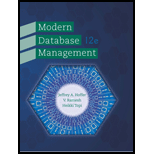
Modern Database Management (12th Edition)
12th Edition
ISBN: 9780133544619
Author: Jeffrey A. Hoffer, Ramesh Venkataraman, Heikki Topi
Publisher: PEARSON
expand_more
expand_more
format_list_bulleted
Concept explainers
Textbook Question
Chapter 3, Problem 3.7RQ
What is the attribute inheritance? Why is it important?
Expert Solution & Answer
Want to see the full answer?
Check out a sample textbook solution
Students have asked these similar questions
List down the strenghts and weaknesses of your team project for Capsim Simulation? Explan.
Capsim Team PowerPoint Presentations - Slide Title: Key LearningsWhat were the key learnings that you discovered as a team through your Capsim simulation?
Write the SQL code that permits to implement the tables: Student and Transcript. NB: Add the constraints on the attributes – keys and other.
Chapter 3 Solutions
Modern Database Management (12th Edition)
Ch. 3 - Define each of the following terms: supertype...Ch. 3 - Prob. 3.2RQCh. 3 - Contrast the following terms: supertype; subtype...Ch. 3 - State two conditions that indicate when a database...Ch. 3 - Prob. 3.5RQCh. 3 - Give an example (other than those discussed in the...Ch. 3 - What is the attribute inheritance? Why is it...Ch. 3 - Give an example of each of the following: a...Ch. 3 - What types of business rules are normally captured...Ch. 3 - What is the purpose of a subtype discriminator?
Ch. 3 - Prob. 3.11RQCh. 3 - In what ways is starting a data modeling project...Ch. 3 - Prob. 3.13RQCh. 3 - Prob. 3.14RQCh. 3 - What do you purchase when you acquire a packaged...Ch. 3 - Prob. 3.16RQCh. 3 - When is a member of a supertype always a member of...Ch. 3 - Examine the hierarchy for the university EER...Ch. 3 - Add a subtype discriminator for each of the...Ch. 3 - For simplicity, subtype discriminators were left...Ch. 3 - Refer to the employee EER diagram in Figure 3-2....Ch. 3 - Refer to the EER diagram for patients in Figure...Ch. 3 - Figure 3-13 shows the development Of entity...Ch. 3 - Refer to Problem and Exercise 2-44 in Chapter 2...Ch. 3 - For a library, the entity type HOLDING has four...Ch. 3 - A bank has three types of accounts: checking,...Ch. 3 - Refer to your answer to Problem and Exercise 2-4...Ch. 3 - Refer to your answer to Problem and Exercise 3-24...Ch. 3 - Prob. 3.29PAECh. 3 - Prob. 3.30PAECh. 3 - Develop an EER model for the following situation,...Ch. 3 - Draw an EER diagram for the following description...Ch. 3 - Prob. 3.33PAECh. 3 - Prob. 3.34PAECh. 3 - Based on the EER diagram constructed for Problem...Ch. 3 - Prob. 3.36PAECh. 3 - Prob. 3.37PAECh. 3 - Add the following to Figure 3-16: An EMPLOYMENT...
Knowledge Booster
Learn more about
Need a deep-dive on the concept behind this application? Look no further. Learn more about this topic, computer-science and related others by exploring similar questions and additional content below.Similar questions
- Draw an ERD that will involve the entity types: Professor, Student, Department and Course. Be sure to add relationship types, key attributes, attributes and multiplicity on the ERD.arrow_forwardDraw an ERD that represents a book in a library system. Be sure to add relationship types, key attributes, attributes and multiplicity on the ERD.arrow_forward2:21 m Ο 21% AlmaNet WE ARE HIRING Experienced Freshers Salesforce Platform Developer APPLY NOW SEND YOUR CV: Email: hr.almanet@gmail.com Contact: +91 6264643660 Visit: www.almanet.in Locations: India, USA, UK, Vietnam (Remote & Hybrid Options Available)arrow_forward
- Provide a detailed explanation of the architecture on the diagramarrow_forwardhello please explain the architecture in the diagram below. thanks youarrow_forwardComplete the JavaScript function addPixels () to calculate the sum of pixelAmount and the given element's cssProperty value, and return the new "px" value. Ex: If helloElem's width is 150px, then calling addPixels (hello Elem, "width", 50) should return 150px + 50px = "200px". SHOW EXPECTED HTML JavaScript 1 function addPixels (element, cssProperty, pixelAmount) { 2 3 /* Your solution goes here *1 4 } 5 6 const helloElem = document.querySelector("# helloMessage"); 7 const newVal = addPixels (helloElem, "width", 50); 8 helloElem.style.setProperty("width", newVal); [arrow_forward
- Solve in MATLABarrow_forwardHello please look at the attached picture. I need an detailed explanation of the architecturearrow_forwardInformation Security Risk and Vulnerability Assessment 1- Which TCP/IP protocol is used to convert the IP address to the Mac address? Explain 2-What popular switch feature allows you to create communication boundaries between systems connected to the switch3- what types of vulnerability directly related to the programmer of the software?4- Who ensures the entity implements appropriate security controls to protect an asset? Please do not use AI and add refrencearrow_forward
arrow_back_ios
SEE MORE QUESTIONS
arrow_forward_ios
Recommended textbooks for you
 Systems ArchitectureComputer ScienceISBN:9781305080195Author:Stephen D. BurdPublisher:Cengage Learning
Systems ArchitectureComputer ScienceISBN:9781305080195Author:Stephen D. BurdPublisher:Cengage Learning Principles of Information Systems (MindTap Course...Computer ScienceISBN:9781285867168Author:Ralph Stair, George ReynoldsPublisher:Cengage Learning
Principles of Information Systems (MindTap Course...Computer ScienceISBN:9781285867168Author:Ralph Stair, George ReynoldsPublisher:Cengage Learning C++ for Engineers and ScientistsComputer ScienceISBN:9781133187844Author:Bronson, Gary J.Publisher:Course Technology Ptr
C++ for Engineers and ScientistsComputer ScienceISBN:9781133187844Author:Bronson, Gary J.Publisher:Course Technology Ptr A Guide to SQLComputer ScienceISBN:9781111527273Author:Philip J. PrattPublisher:Course Technology Ptr
A Guide to SQLComputer ScienceISBN:9781111527273Author:Philip J. PrattPublisher:Course Technology Ptr Management Of Information SecurityComputer ScienceISBN:9781337405713Author:WHITMAN, Michael.Publisher:Cengage Learning,
Management Of Information SecurityComputer ScienceISBN:9781337405713Author:WHITMAN, Michael.Publisher:Cengage Learning,

Systems Architecture
Computer Science
ISBN:9781305080195
Author:Stephen D. Burd
Publisher:Cengage Learning

Principles of Information Systems (MindTap Course...
Computer Science
ISBN:9781285867168
Author:Ralph Stair, George Reynolds
Publisher:Cengage Learning

C++ for Engineers and Scientists
Computer Science
ISBN:9781133187844
Author:Bronson, Gary J.
Publisher:Course Technology Ptr


A Guide to SQL
Computer Science
ISBN:9781111527273
Author:Philip J. Pratt
Publisher:Course Technology Ptr

Management Of Information Security
Computer Science
ISBN:9781337405713
Author:WHITMAN, Michael.
Publisher:Cengage Learning,
Enhanced Entity Relationship Model; Author: Data Science Center;https://www.youtube.com/watch?v=ocQUtXPumdQ;License: Standard YouTube License, CC-BY